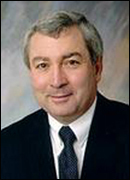
Providence seems to have guided Bob Bernhard through a lifetime of experience just exactly for his new job.
Since arriving Aug. 1, the vice president of research at Notre Dame has had to hit the ground running on several fronts. As the first administrator to focus exclusively on the Universitys research enterprisehis predecessors also administered the graduate schoolhe will direct Notre Dames aspirations to significantly grow its outside research funding and overall research/scholarship reputation.
Bernhard is a key player in advancing Provost Thomas Burishs initiative known as SAPC (Strategic Academic Planning Committee). It will provide seed funding to a handful of major new initiatives that will help grow the Universitys research identity. Some $40 million in support has been committed for distribution; 10 projects are being developed and reviewed for selection.
Then theres the launching, beginning next spring, of Innovation Park @ Notre Dame.
These tall orders are being carried out by someone who has directed similar challenges at Purdue University, where he was on the faculty and administration for 25 years and most recently served as an associate vice president of research responsible for managing research centers and major shared research facilities.
More than his nuts-and-bolts expertise, Bernhard has experienced a sense of the possible, and his view is worth hearing.
Investment similar to SAPC in Purdue changed the research enterprise there,he said.I have seen it done.
He expects to see it done again, he said, because the investment Notre Dame plans to make in stepping up its research profileis, per capita, a greater investment than Purdue made.
Besides financial resources, Bernhard has been struck by the human support for this transformation.
When I looked at how we would do this large effort, I was impressed that faculty were mobilized and excited and well prepared, that resources were available, and that alumni and donors are committed to this,he said.
Community leaders also are enthusiastic about supporting Notre Dames growing research identity.
That was the landscape Bernhard surveyed as he prepared to move from West Lafayette. When SAPC proposals rolled in during the fall, Bernhard experienced the enthusiasm firsthand. Seventy-two teams had submitted proposals for seed funding.
Thats a lot of energy,he said.
He recalled his own experience at Purdue during its transformation. The call for creative ideasenergized the faculty. You could propose a new idea and someone would listen. Also, not everything was required to succeed, which reduced the risk for faculty. If we tried something innovative, we had the opportunity for a big win, or we made an honest evaluation, sunset the effort and went on to other new things. This was very stimulating.
Bernhard describes his Purdue years as including three careers: professor of mechanical engineering with a heavy emphasis on research, director of a major research center, and central-office administrator.
Every step was an adventure and stepping stone to the next opportunity,he said.
He had remarked to others that he would never have to leave because there were so many interesting opportunities there.
However, to be a part of the transformative vision that Notre Dames president. Rev. John I. Jenkins, C.S.C., articulated about the Universitys research growth was a once-in-a-lifetime opportunity. Also attractive: the call to do researchfor good,and the opportunity to explore research solutions on global issueswithout a focus on the return on investment, because its the right thing to do.
Notre Dames quest to advance the scope, excellence and visibility of its research enterprise comes at a key time in the nations approach to solving problems. Previously, Bernhard explained, funding agencies would break a problem into tiny pieces, figuring the discipline-specific orientation coupled into the best capability the university could offer. However, thissiloapproach made it difficult to address a problem holistically.
Funding agencies have recently become more willing, even eager, to ask universities to propose and seek integrated solutions through interdisciplinary activities. The issue of energy, for example, is technological and scientific, but also behavioral and interrelated to business and economics. Universities are being asked to partner with each other to address the entire problem.
Notre Dame has an advantage in responding to this holistic perspective. First, the mission to do good for humankind is itself holistic.
Also, said Bernhard,Were small and nimble. We can bring social sciences, sciences, humanities and engineering together very quickly, with contributions from law, business and architecture.
With 72 proposals recently produced, the faculty demonstrated no shortage of great ideas. To put that creativity to best effect, Bernhard said he will turn his attention toward building an infrastructure of personnel and resources. The creators of these ideas can concentrate on the research while others provide support and ensure that the buzz of these unique ideas is heard well beyond campus.
p.
TopicID: 25846